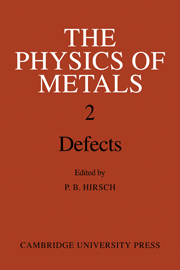2 - Crystal Dislocations
Published online by Cambridge University Press: 04 August 2010
Summary
INTRODUCTION
Before direct observations could be made on dislocations there were four main classes of experimental evidence pointing to the existence of a class of crystal imperfections which we now analyse in terms of the dislocation concept. The earliest body of evidence was that from X-ray diffraction: within a year or two of the discovery of this phenomenon by Friedrich, Knipping, and von Laue in 1912, it became evident that the diffraction intensities from most real crystals were very different from those one would calculate on the assumption of ideal crystal structures. A rather ill-defined concept of mosaic structure was employed for a generation to account in general terms for these discrepancies. We have ultimately learnt that their cause is sometimes well described by the term ‘mosaicstructure’, sometimes not, but in either case we are able to describe the inferred departure from the ideal structure in some detail in terms of dislocations. The next body of evidence was concerned with the mechanical properties of solids, which, to put it briefly, are a thousand times weaker than ideal crystals. The fact became increasingly evident as people acquired confidence in the Born type of model for the ideal crystal, which accounts very well for the elastic or thermal properties, but indicates plastic strengths vastly in excess of those of technical materials. It was to explain these discrepancies that Taylor and Orowan independently put forward the concept of crystal dislocations in 1934.
- Type
- Chapter
- Information
- The Physics of Metals , pp. 43 - 97Publisher: Cambridge University PressPrint publication year: 1976



